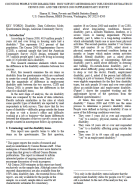
An official website of the United States government
Here’s how you know
Official websites use .gov
A .gov website belongs to an official government organization in the United States.
Secure .gov websites use HTTPS
A lock (
) or https:// means you’ve safely connected to the .gov website. Share sensitive information only on official, secure websites.
-
//
- Census.gov /
- Library /
- Census Working Papers /
- Counting People with Disabilities
Counting People with Disabilities: How Survey Methodology Influences Estimates in Census 2000 amd Census 2000 Supplementary Survey
Counting People with Disabilities: How Survey Methodology Influences Estimates in Census 2000 amd Census 2000 Supplementary Survey
Introduction
According to Census 2000, 48.9 million people 5 years old and over living in housing units had a disability. 2 This represents 19.2 percent of that population. The Census 2000 Supplementary Survey (C2SS), a national sample that used the American Community Survey (ACS) design, estimated that 39.7 million people aged 5 and over living in housing units (15.6 percent) had a disability. This research examines elements which cause the difference in the disability estimates between two sources. First, this research examines the six items on disability from the questionnaire which are combined to create the overall disability rate. This step reveals that the magnitude of di fference in employment disability rates between the two surveys, C2SS and Census 2000, is greater than the differences in the other five disability items. In the next stage of analysis, the six disability items are compared by the mode of data collection. Results indicate similarities in the rates at which some specific types of disability are reported by mail respondents in both surveys. They show that for two types of disability—difficulty going outside the home to shop or visit a doctor’s office and difficulty working at a job or business—the larger differences between the estimates of the two surveys occur in the people counted in nonresponse follow-up operations.
Share
Related Information
WORKING PAPER
Disability Working PapersSome content on this site is available in several different electronic formats. Some of the files may require a plug-in or additional software to view.
 Yes
Yes
 No
NoComments or suggestions?


Top

